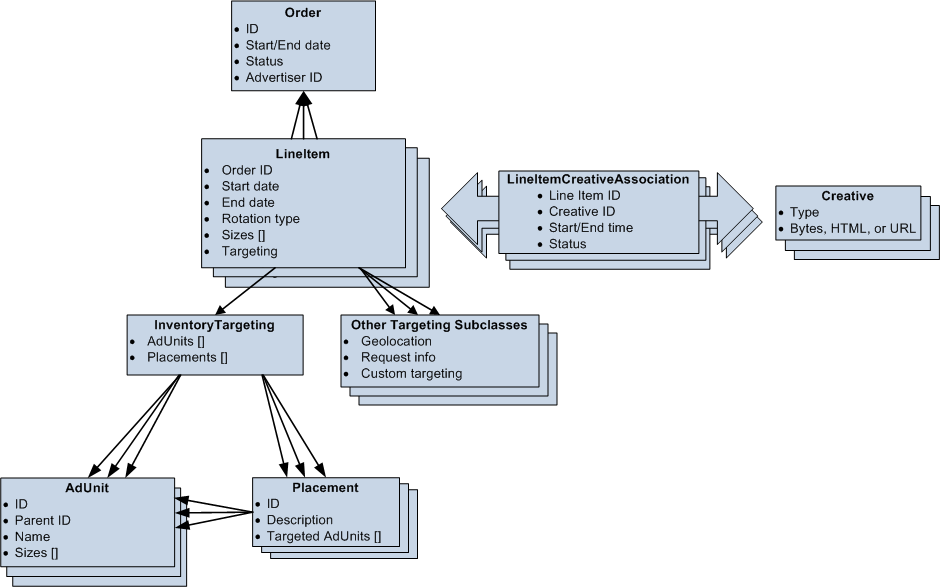หน้านี้แสดงภาพรวมสถาปัตยกรรมของ Google Ad Manager API และอธิบายแนวคิดและข้อกำหนดทั่วไปใน Ad Manager
สถาปัตยกรรม API
ต่อไปนี้เป็นแผนภาพแบบง่ายของคลาสหลักใน Ad Manager API และความเกี่ยวข้องกัน

สั่งซื้อ
- ออบเจ็กต์
Orderมีข้อมูลทั่วไปเกี่ยวกับคำสั่งซื้อ เช่น สกุลเงินหรือพนักงานขาย และมีอินสแตนซ์LineItemอย่างน้อย 1 รายการ ในโค้ดLineItemแต่ละรายการจะเก็บรหัสของOrderที่มีอยู่ ไม่ใช่Orderที่มีรายการออบเจ็กต์LineItem LineItem
- ออบเจ็กต์
LineItemอธิบายถึงชุดข้อกำหนดในการแสดงโฆษณา รวมถึงวิธีและเวลาที่จะแสดงโฆษณา ขนาดของครีเอทีฟโฆษณาที่จะแสดง และลำดับในการแสดงโฆษณา (ตามลำดับ ถ่วงน้ำหนัก หรือตามประสิทธิภาพ) ลำดับความสำคัญของโฆษณา และพร็อพเพอร์ตี้มากมายที่อธิบายโครงสร้างต้นทุนLineItemมีออบเจ็กต์InventoryTargeting1 รายการที่อธิบายออบเจ็กต์AdUnitและPlacementที่กําหนดเป้าหมายได้ และออบเจ็กต์คลาสย่อยTargetingเพิ่มเติมที่ไม่บังคับที่แสดงถึงภูมิศาสตร์ ที่กําหนดเอง หรือเกณฑ์อื่นๆ LineItemCreativeAssociation
LineItemCreativeAssociation(มักเรียกว่า LICA) ลิงก์ 1LineItemไปยังCreativeคุณลิงก์รายการโฆษณากับครีเอทีฟโฆษณาได้มากกว่า 1 รายการ และคุณอาจลิงก์ครีเอทีฟโฆษณากับรายการโฆษณาได้มากกว่า 1 รายการ ทั้งนี้ขึ้นอยู่กับประเภทบัญชีที่ใช้ เมื่อคุณสร้างLineItemCreativeAssociationก่อนอื่น Ad Manager จะตรวจสอบว่าทั้งครีเอทีฟโฆษณาและรายการโฆษณาใช้งานร่วมกันได้หรือไม่ เช่น หากขนาดแตกต่างกัน คุณจะได้รับข้อผิดพลาดเมื่อพยายามสร้างหรืออัปเดตการเชื่อมโยง ออบเจ็กต์นี้ยังให้คุณลบล้างค่าบางค่าในLineItemที่เชื่อมโยงได้ด้วย เช่น วันที่เริ่มต้น/สิ้นสุด หรือขนาด (หากคุณมีครีเอทีฟโฆษณาที่มีขนาดไม่พอดีกับขนาดที่รายการโฆษณาระบุไว้ แต่คุณยินดีให้ Ad Manager ปรับขนาดครีเอทีฟโฆษณาให้พอดีกับหน่วยโฆษณาได้อย่างรวดเร็ว) LICA จะไม่แสดงในอินเทอร์เฟซผู้ใช้ของ Ad Manager เนื่องจากเป็นรูปแบบ APIครีเอทีฟโฆษณา
Creativeแสดงโฆษณาจริง หากโฆษณาโฮสต์โดย Ad Manager ออบเจ็กต์นี้จะเก็บไบต์รูปภาพ ไฟล์ Flash หรือแท็ก HTML ที่กำหนดเองจริงๆ ที่จัดเก็บไว้ในเซิร์ฟเวอร์ของ Ad Manager หากครีเอทีฟโฆษณาโฮสต์อยู่ในเว็บไซต์ของบุคคลที่สาม ครีเอทีฟโฆษณาจะเป็น URL หรือข้อมูลโค้ด HTML ที่ส่งคำขอจากเซิร์ฟเวอร์ของบุคคลที่สามคลาสย่อยการกำหนดเป้าหมายพื้นที่โฆษณาและการกำหนดเป้าหมาย
- ออบเจ็กต์
InventoryTargetingแสดงรายการหน่วยโฆษณาที่เชื่อมโยงกับLineItemที่เฉพาะเจาะจง คุณระบุเกณฑ์การกำหนดเป้าหมายเพิ่มเติมที่ไม่บังคับได้โดยใช้อินสแตนซ์เพิ่มเติมของคลาสย่อยTargetingที่เหมาะสม ตำแหน่งโฆษณา
- ออบเจ็กต์
Placementคือคอลเล็กชันของออบเจ็กต์AdUnitอย่างน้อย 1 รายการ AdUnit
AdUnitหมายถึงตำแหน่งของโฆษณาในหน้าเว็บอย่างน้อย 1 หน้าAdUnitอาจเป็นเป้าหมายของออบเจ็กต์InventoryTargetingของLineItemหรือออบเจ็กต์Placementก็ได้ ออบเจ็กต์AdUnitมีขนาด รหัส และชื่อที่ไม่ซ้ำกัน รหัสนี้ใช้สำหรับระบุออบเจ็กต์AdUnitอื่นๆ ภายใน API ชื่อนี้จะใช้เป็นตัวระบุที่ไม่ซ้ำกันในแท็ก HTML เพื่อระบุออบเจ็กต์AdUnitที่เจาะจง และส่งกลับไปยัง Ad Manager โดยเป็นส่วนหนึ่งของคำขอหน้าเว็บ

